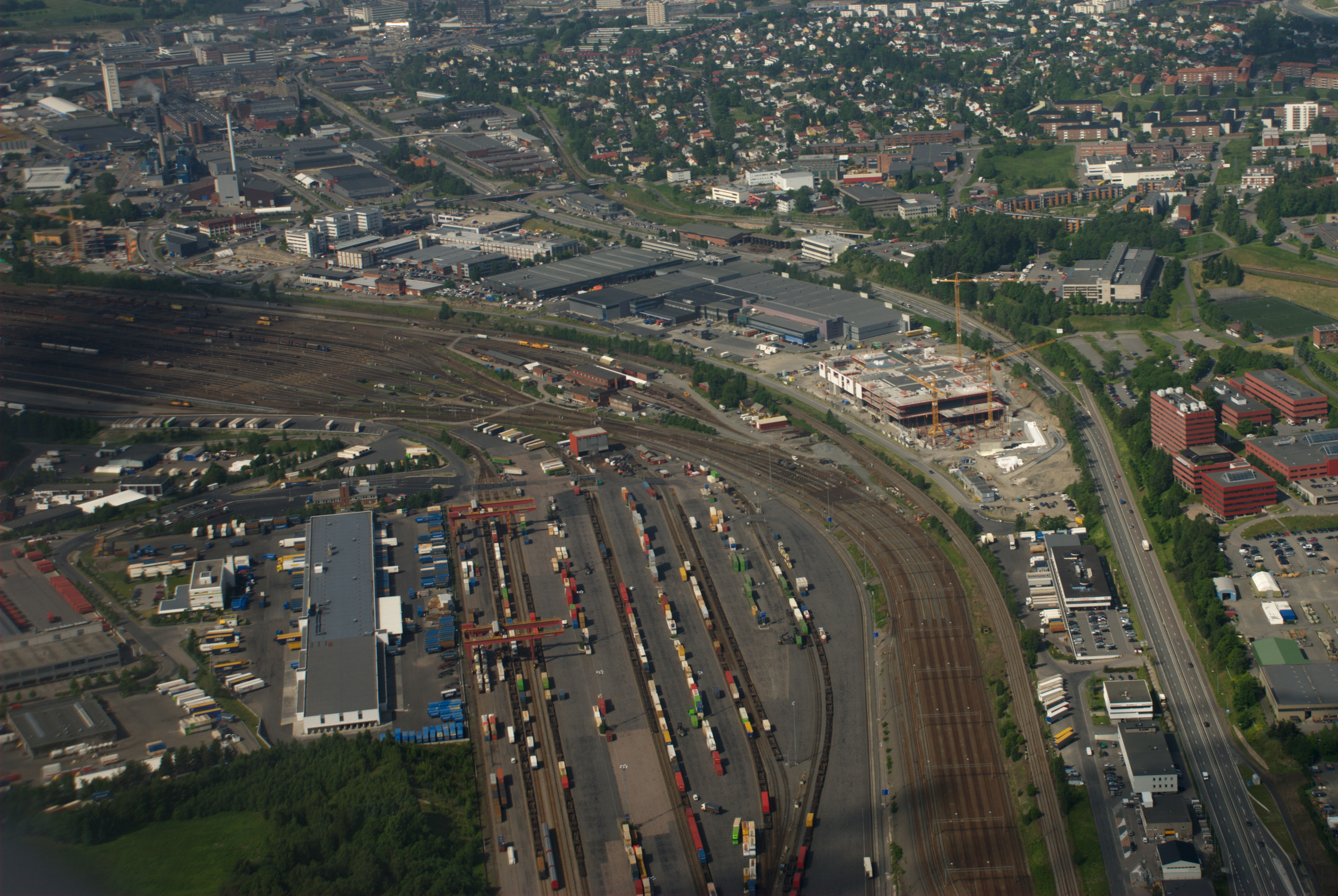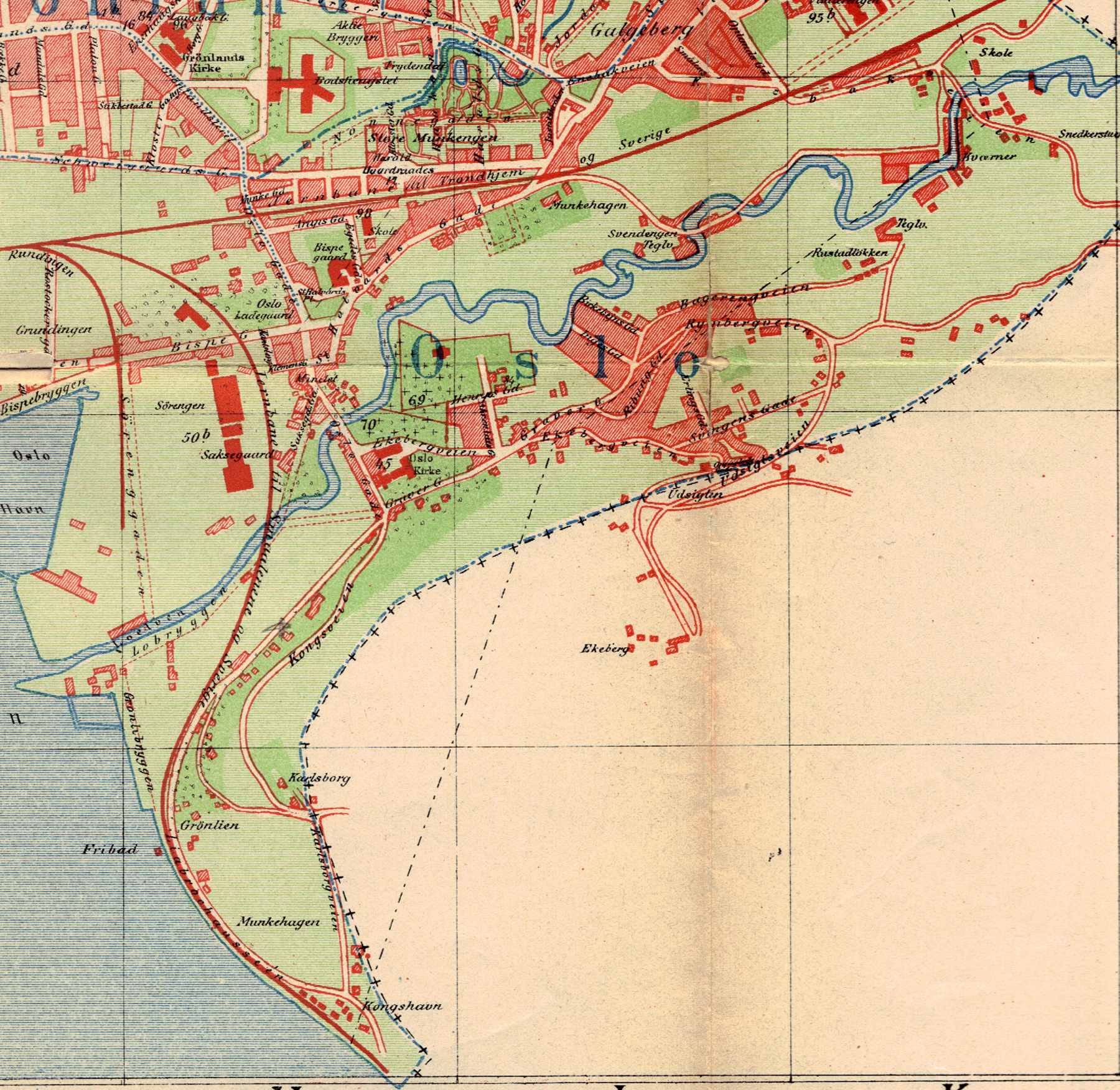|
Loenga–Alnabru Line
The Loenga–Alnabru Line ( no, Loenga–Alnabrulinjen) is a freight-only railway line in Oslo, Norway. It runs from the classification yard at Loenga(Norway) to Alnabru Freight Terminal, typically serving twenty trains per day. It allows trains to pass from the Østfold Line to Alnabru without passing via Oslo Central Station. It is also used by freight trains from the Sørlandet Line, which run via the Oslo Tunnel and cross over at Bryn Station. It is notorious for the steep hill Brynsbakken which it has to climb, giving it a gradient of 2.6 percent. The line was opened from Bryn to Alnabru Station in 1904, with completion to Loenga on 1 May 1907. The line was electrified in 1928. A new classification yard opened at Alnabru in 1970. The line was the site of the Sjursøya Accident in 2010. In order to bypass Brynsbakken, the Norwegian National Rail Administration has proposed building a tunnel from further south on the Østfold Line, named the Bryn Diagonal. Route ... [...More Info...] [...Related Items...] OR: [Wikipedia] [Google] [Baidu] |
Trunk Line
In telecommunications, trunking is a technology for providing network access to multiple clients simultaneously by sharing a set of circuits, carriers, channels, or frequencies, instead of providing individual circuits or channels for each client. This is reminiscent to the structure of a tree with one trunk and many branches. Trunking in telecommunication originated in telegraphy, and later in telephone systems where a trunk line is a communications channel between telephone exchanges. Other applications include the trunked radio systems commonly used by police agencies. In the form of link aggregation and VLAN tagging, trunking has been applied in computer networking. Telecommunications A trunk line is a circuit connecting telephone switchboards (or other switching equipment), as distinguished from local loop circuit which extends from telephone exchange switching equipment to individual telephones or information origination/termination equipment. Trunk lines are used fo ... [...More Info...] [...Related Items...] OR: [Wikipedia] [Google] [Baidu] |
Etterstad
Etterstad () is a neighborhood in Oslo, located between the river Alna and Strømsveien, north of Vålerenga. It was incorporated into Oslo in 1946, two years before the merger of Oslo and Aker. The area is mainly residential. History The area takes its name from Etterstad Farm, that was located close to the present Helsfyr area, about where the current Helsfyr T-bane station is located. The farm name is Old Norse and is a contraction of ''Eitill'' (a person's name) and ''stad'' (meaning "place"). Records of the farm are recorded back to 1396 as an estate of the bishop. It remained church property until 1795 when it was taken over by the city and made a military training field, in exchange for a rent paid by the city to the bishop. At the time the city was obliged to provide ground for the military. The military gave the area the name ''Etterstadsletta'', and was in use as a training field until 1881. In 1821, King Charles XIV John ordered an exercise with 6,000 soldiers as ... [...More Info...] [...Related Items...] OR: [Wikipedia] [Google] [Baidu] |
Norway
Norway, officially the Kingdom of Norway, is a Nordic country in Northern Europe, the mainland territory of which comprises the western and northernmost portion of the Scandinavian Peninsula. The remote Arctic island of Jan Mayen and the archipelago of Svalbard also form part of Norway. Bouvet Island, located in the Subantarctic, is a dependency of Norway; it also lays claims to the Antarctic territories of Peter I Island and Queen Maud Land. The capital and largest city in Norway is Oslo. Norway has a total area of and had a population of 5,425,270 in January 2022. The country shares a long eastern border with Sweden at a length of . It is bordered by Finland and Russia to the northeast and the Skagerrak strait to the south, on the other side of which are Denmark and the United Kingdom. Norway has an extensive coastline, facing the North Atlantic Ocean and the Barents Sea. The maritime influence dominates Norway's climate, with mild lowland temperatures on the se ... [...More Info...] [...Related Items...] OR: [Wikipedia] [Google] [Baidu] |
Oslo
Oslo ( , , or ; sma, Oslove) is the capital and most populous city of Norway. It constitutes both a county and a municipality. The municipality of Oslo had a population of in 2022, while the city's greater urban area had a population of in 2019, and the metropolitan area had an estimated population of in 2021. During the Viking Age the area was part of Viken. Oslo was founded as a city at the end of the Viking Age in 1040 under the name Ánslo, and established as a ''kaupstad'' or trading place in 1048 by Harald Hardrada. The city was elevated to a bishopric in 1070 and a capital under Haakon V of Norway around 1300. Personal unions with Denmark from 1397 to 1523 and again from 1536 to 1814 reduced its influence. After being destroyed by a fire in 1624, during the reign of King Christian IV, a new city was built closer to Akershus Fortress and named Christiania in honour of the king. It became a municipality ('' formannskapsdistrikt'') on 1 January 1838. The city fu ... [...More Info...] [...Related Items...] OR: [Wikipedia] [Google] [Baidu] |
Railway Line
Rail terminology is a form of technical terminology. The difference between the American term ''railroad'' and the international term ''railway'' (used by the International Union of Railways and English-speaking countries outside the United States) is the most significant difference in rail terminology. These and other terms have often originated from the parallel development of rail transport systems in different parts of the world. In English-speaking countries outside the United Kingdom, a mixture of US and UK terms may exist. Various global terms are presented here. Where a term has multiple names, this is indicated. The abbreviation "UIC" refers to standard terms adopted by the International Union of Railways in its official publications and thesaurus. 0–9 A B ... [...More Info...] [...Related Items...] OR: [Wikipedia] [Google] [Baidu] |
Sjursøya
Sjursøya is a peninsula located in Oslo, Norway. The peninsula is entirely used by the Port of Oslo as a container and petroleum port, and serves as the primary oil port for Eastern Norway. A train accident occurred at Sjursøya on 24 March 2010, when a runaway set of 16 empty carriages belonging to CargoNet CargoNet AS is the primary operator of freight rail transport, freight trains on the rail transport in Norway, Norwegian railway system. It was formed as NSB Gods after Vy (transport operator), NSB (now Vy) fissioned into a passenger and a frei ... crashed into a terminal building at high speed. This incident caused 3 deaths and 4 injured persons. The name The first element is the genitive form of the male name ''Sjur'' (from Norse ''Sigurðr'') - the last element is the finite form of øy ('island'). References Landforms of Oslo Peninsulas of Norway {{Oslo-geo-stub ... [...More Info...] [...Related Items...] OR: [Wikipedia] [Google] [Baidu] |
Ski Station
Ski Station ( no, Ski stasjon) is a railway station located in Ski, Norway. It is located from Oslo Central Station on the Østfold Line, at the point where the railway splits in two into an eastern and western line. It also serves as the terminal station of the Follo Line. The station is served by all passenger trains on the Østfold Line and Follo Line. This includes regional services to Halden Station and Gothenburg Central Station, as well as Oslo Commuter Rail services to Moss Station and Mysen Station. Ski is also the terminal station for a commuter train service to Oslo that stops at all stations on the Østfold Line. The restaurant at the station was taken over by Norsk Spisevognselskap on 1 January 1921, but leased to private operators. After an agreement with Norwegian State Railways, Spisevognselskapet renovated the restaurant and took over operations again on 1 January 1924. It was closed on 14 April 1946. New station In the mid 1990s, the Østfold Line betwe ... [...More Info...] [...Related Items...] OR: [Wikipedia] [Google] [Baidu] |
Østfold Line
The Østfold Line ( no, Østfoldbanen) is a railway line which runs from Oslo through the western parts of Follo and Østfold to Kornsjø in Norway. It continues through Sweden as the Norway/Vänern Line. The northern half is double track and the entire line is electrified. It serves a combination of commuter, regional and freight trains and is the main rail corridor in the south of Norway. The Follo Line runs parallel to the Østfold Line in tunnel. The Eastern Østfold Line branches off at Ski Station and runs before rejoining at Sarpsborg Station. The line opened as the Smaalenene Line () on 2 January 1879. Stations were designed by Peter Andreas Blix. It was the first railway in Norway to predominantly build bridges and viaducts with iron. The line underwent upgrades from 1910 through 1940 in which the section from Oslo to Ski received double track, the permitted weight and speeds were increased and the line was electrified. From 1989 to 1996 the section from Ski to Sandbuk ... [...More Info...] [...Related Items...] OR: [Wikipedia] [Google] [Baidu] |
Gamlebyen
The Old Town of Oslo ( no, Gamlebyen, ) is a neighbourhood in the inner city of Oslo, Norway, belonging to the borough of Gamle Oslo and is the oldest urban area within the current capital. This part of the capital of Norway was simply called Oslo until 1925 while the city as a whole was called ''Kristiania''. Oslo's old town was established with the urban structure around the year 1000 and was the capital of Norway's dominion in 1314. The main Old Town area (i.e. the southern and central parts of Old Town) has several ruins of stone and brick lying above ground, and large amounts of protected culture underground. The core area also has listed 1700s buildings. Towards Ekeberg slope and further up are some 17th and 18th-century wooden houses that are zoned for conservation under the Planning and Building Act, though there exist in the Old Town many four-storey brick houses, built at the end of the 1800s, and some heritage railway buildings from different eras. Mediaeval Oslo ... [...More Info...] [...Related Items...] OR: [Wikipedia] [Google] [Baidu] |
Galgeberg
Galgeberg () is a neighbourhood in the borough of Gamle Oslo in Oslo, Norway. The neighbourhood lies near Vålerenga, Kampen and Gamlebyen. The name stems from the gallows A gallows (or scaffold) is a frame or elevated beam, typically wooden, from which objects can be suspended (i.e., hung) or "weighed". Gallows were thus widely used to suspend public weighing scales for large and heavy objects such as sacks ... present at the location in earlier times. References Neighbourhoods of Oslo {{Oslo-geo-stub ... [...More Info...] [...Related Items...] OR: [Wikipedia] [Google] [Baidu] |





